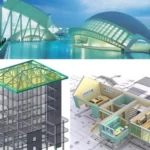Steps of designing a concrete structure
To ensure a safe, functional, and long-lasting outcome, the design of a concrete structure involves several essential stages. Here are the typical phases of the design procedure:
Determine Design Requirements: Determine the design requirements for the project, including the structure’s purpose, intended use, burden requirements, desired lifespan, and any specific design criteria or constraints.
Site Investigation and Analysis:Conduct a thorough site investigation to acquire information about the soil conditions, groundwater levels, seismicity, and any other relevant factors that can influence the design and construction of the concrete structure.
Structural analysis:Analyze the structure to determine the loads acting on it, including dead loads (self-weight), live loads, atmospheric loads, seismic loads, and any other applicable loads. Calculate the structure’s reactions, internal forces, and moments.
Select Structural System: Choose an appropriate structural system for the concrete structure based on the analysis and design specifications. Consider variables including span lengths, vertical and lateral stresses, architectural considerations, construction feasibility, and budget.
Design Structural Elements: Based on the selected structural system, design individual structural elements such as beams, columns, slabs, and foundations. Determine their dimensions, reinforcement requirements, and connections. Consider factors such as durability, usability, strength, and safety.
Reinforcement design:Determine the quantity, placement, and detailing of reinforcement bars required for each structural element as part of the reinforcement design. Consider the material properties of the concrete, the anticipated loads, and the intended performance of the structure under various conditions.
Deflection and crack control:Analyze and design for deflection and crack control to ensure the structure satisfies the required serviceability criteria. Consider factors including deflection limits, contraction, temperature effects, control joints, and reinforcement.
Stability analysis:Analyze the structure’s stability to ensure that it can withstand overturning, sliding, and excessive deformation. Consider lateral stresses, such as wind or seismic forces, and design appropriate bracing or shear walls to improve stability.
Construction details:Develop detailed construction drawings and specifications that provide explicit instructions for the building process. Include dimensions, reinforcement information, connections, construction junctions, and any other pertinent details.
Evaluate and Approval: Have structural engineers or the appropriate authorities evaluate the design to ensure compliance with local building codes, regulations, and safety standards. Address any necessary feedback or modifications.
Construction and quality control:During the construction phase, ensure that the concrete structure is constructed in accordance with the approved design and specifications. Implement quality control measures, conduct inspections, and carry out the necessary tests to ensure that concrete placement, reinforcement installation, and curing procedures are carried out correctly.
It is essential to note that the design process can vary based on the complexity and size of the concrete structure, as well as local building codes and regulations. To ensure a successful design, it is essential to consult with seasoned structural engineers and other professionals in the field.
Disclaimer: This content is provided solely for your review. Erusu Consultants takes no liability for this article. The reader is advised to form their own opinion. Please consult a structural engineer before making any final decisions.






